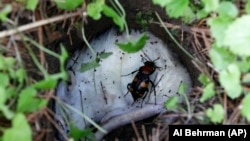Like all good parents, some beetles go to great lengths, or do a lot, for their offspring. To humans, though, some of this beetle behavior can be surprising or even gross.
To feed their future offspring, beetles look for dead animals, like mice or birds. But before burying the animals for safe keeping, the insects clean the skin and roll the body into a ball. Then they cover the body in a thick liquid sometimes called goop. (Technically it is called “gut secretions.”)
Scientists used to think this goop was only used to slow the decaying process. Now, however, they think it does more than that. It might also hide the smell of the decaying body and create another smell that tricks other competitors in search of food.
The leader of the research, Stephen Trumbo, said this goop “helps them to hide their resource from others. They try to keep everyone away.”
Trumbo studies animal behavior at the University of Connecticut. The findings were recently published in a study appearing in The American Naturalist.
Not surprisingly, these beetles are called burying beetles. And in nature, they are not the only the creatures who try to trick their competitors or animals they hunt. Take for example a flower called the Corpse flower. It produces rotting smells to appeal to insect pollinators. This makes sure the flower will continue to live on.
In nature, there is much competition for food. When an animal dies, other animals that feed on dead bodies, called scavengers, race to find the bodies. Scavengers -- such as burying beetles, vultures, opossums, maggots, and others -- use many different senses and body parts to do this. Burying beetles, for example, use special antennae to find the remains from far away.
Burying beetles are large, about two-and-half centimeters long. They are black with orange markings. Their gut secretion -- the goop they put on the dead bodies -- is antibacterial and slows down the decaying process.
Trumbo and his team carried out experiments to try to answer one main question: Can the goop also cover the decaying smell and prevent other animals from finding the food?
To do this, they looked at burying beetles found in the forests of North America. They collected the gases that come off dead hairless mice – a popular food source for the burying beetle.
The researchers then compared the gases coming off the bodies of the untouched mice (without goop) with the gases coming off the ones prepared by the burying beetles (with goop.)
The bodies with the beetle goop gave off much less of a strong-smelling compound that usually brings other burying beetles. The scientists also found an increase in another kind of gas found in decaying bodies. That gas is known to deter other insects that feed on dead animals.
Next, they dropped off the dead mice in a Connecticut forest. Results of the experiments showed that the beetle’s competitors were less likely to discover the mice that were covered in goop.
Daniel Rozen is a biologist at Leiden University in the Netherlands. He was not involved in the research. But he said of the findings: “If you can deter other scavengers, even for a little bit of time, it can buy you a lot.”
I’m Anna Matteo.
Marion Renault reported this story for The Associated Press. anna Matteo adapted it for VOA Learning English. Bryan Lynn was the editor.
___________________________________________________________
Words in This Story
offspring – n. the young of an animal or plant
gut – n. the internal organs of an animal
secretion – n. biology : a substance produced and given off by a plant or animal part
decay – v. to be slowly destroyed by natural processes : to be slowly broken down by the natural processes that destroy a dead plant or body
pollinator – n. an agent such as an insect that pollinates flowers
scavenger – n. an animal that feeds on dead or decaying material
antennae – n. a thin sensitive organ on the head of an insect, crab, etc., that is used mainly to feel and touch things
deter – v. to cause (someone) to decide not to do something : to prevent something from happening










